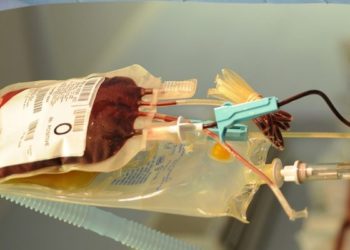Development of a probability model for bleeding after pediatric tonsillectomy
1. Among pediatric patients undergoing tonsillectomy, the median predicted rate of post-operative bleeding requiring emergency care or hospital admission is nearly 2%.
2. This study created a probability model for post-tonsillectomy bleeding rates, which can be used by surgeons and future research groups to compare patients, subpopulations, and institutions.
Evidence Rating Level: 2 (Good)
Study Rundown: Tonsillectomy is a common procedure performed on children suffering from conditions like recurrent tonsillitis and obstructive sleep apnea. However, post-tonsillectomy hemorrhage has been identified as a major cause for hospital readmission and even death post-surgery. Surgeons are encouraged to keep track of post-tonsillectomy bleeding rates for individual patients, but reliable estimates for comparison are lacking. This study aimed to build a probability model of post-tonsillectomy bleeding in pediatric populations to enable surgeons to compare their individual data with the model. The primary objective of the study was to assess the revisit rates to emergency departments or hospitals for bleeding within 30 days after index discharge. Among a cohort of children in the United States, the median post-tonsillectomy bleeding rate was 1.97%. Although the study conducted a multivariable analysis for demographic characteristics and comorbidities, it did not account for all risk factors for bleeding, such as surgical technique and history of bleeding disorders, which could have impacted the results. Nevertheless, these findings offer surgeons a valuable tool to better monitor the bleeding rates of their pediatric patients and take the appropriate measures to minimize the risk of complications if needed.
Click to read the study in JAMA Otolaryngology–Head & Neck Surgery
Relevant Reading: Postoperative complications in pediatric tonsillectomy and adenoidectomy in ambulatory vs inpatient settings
In-Depth [retrospective cohort]: This study analyzed data from over 49 children’s hospitals in the United States to examine the occurrence of postoperative bleeding in pediatric patients who underwent tonsillectomy between January 2016 and August 2021. The study included 96,415 patients, with a mean age of 5.3 years, and 41,284 females (42.8%). Among these patients, 2100 (2.18%) returned to the hospital with postoperative bleeding within 30 days of discharge. The study predicted the 50th and 95th percentiles for post-tonsillectomy bleeding to be 1.97% and 4.75%, respectively. Patient-specific factors that increased the risk of post-tonsillectomy bleeding were also identified, including Hispanic ethnicity, residing in a high-opportunity zip code, gastrointestinal disease, obesity, and adolescent age. On the other hand, Black race was associated with a decreased risk of bleeding. These findings provide valuable insight for healthcare professionals and patients alike to understand the risks associated with tonsillectomy and take appropriate measures to mitigate them.
Image: PD
©2023 2 Minute Medicine, Inc. All rights reserved. No works may be reproduced without expressed written consent from 2 Minute Medicine, Inc. Inquire about licensing here. No article should be construed as medical advice and is not intended as such by the authors or by 2 Minute Medicine, Inc.




![Reinnervation of cardiac infarcts decreases subsequent arrhythmia incidence [PreClinical]](https://www.2minutemedicine.com/wp-content/uploads/2015/02/1280px-Heart_ant_wall_infarction-350x250.jpg)


